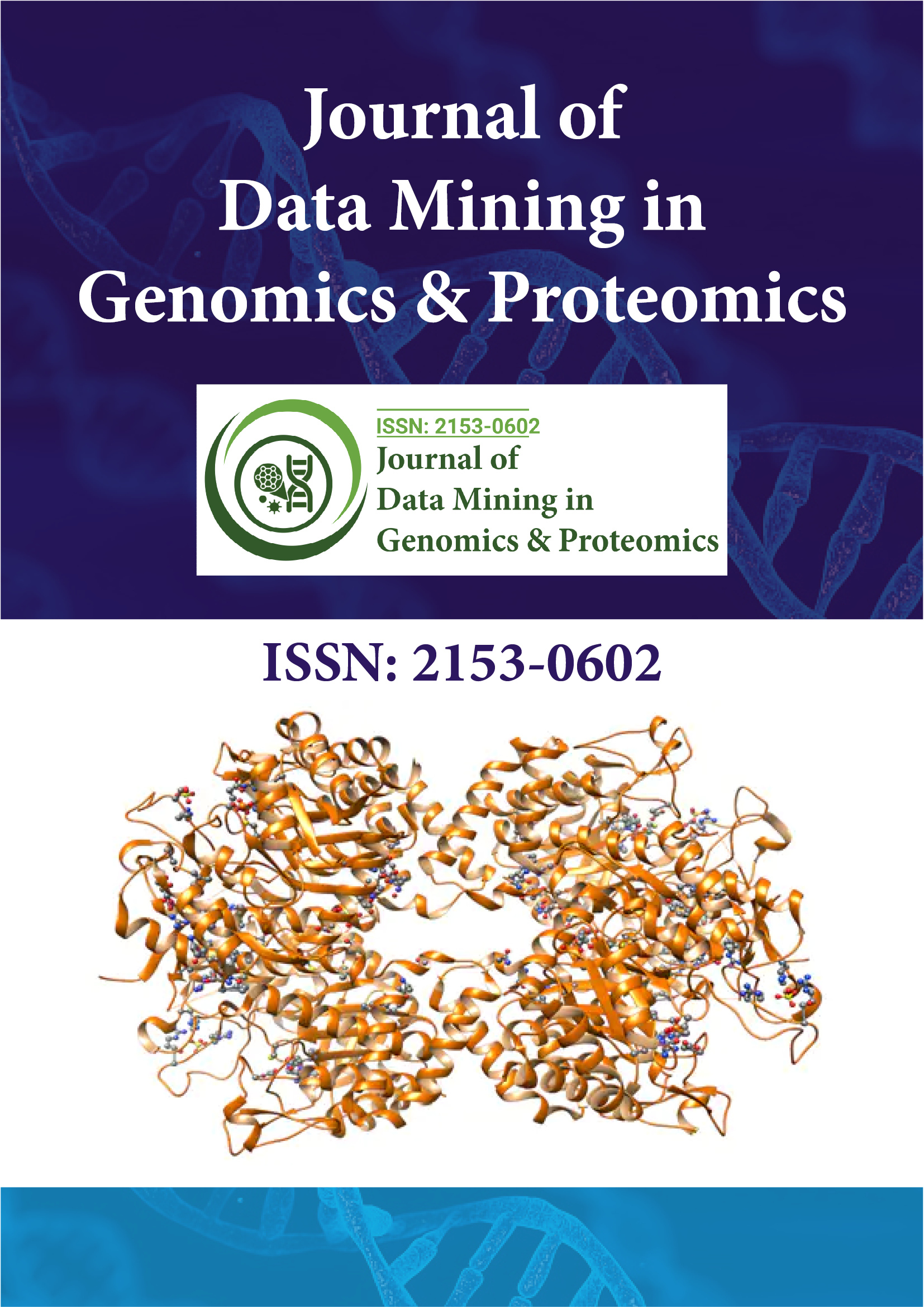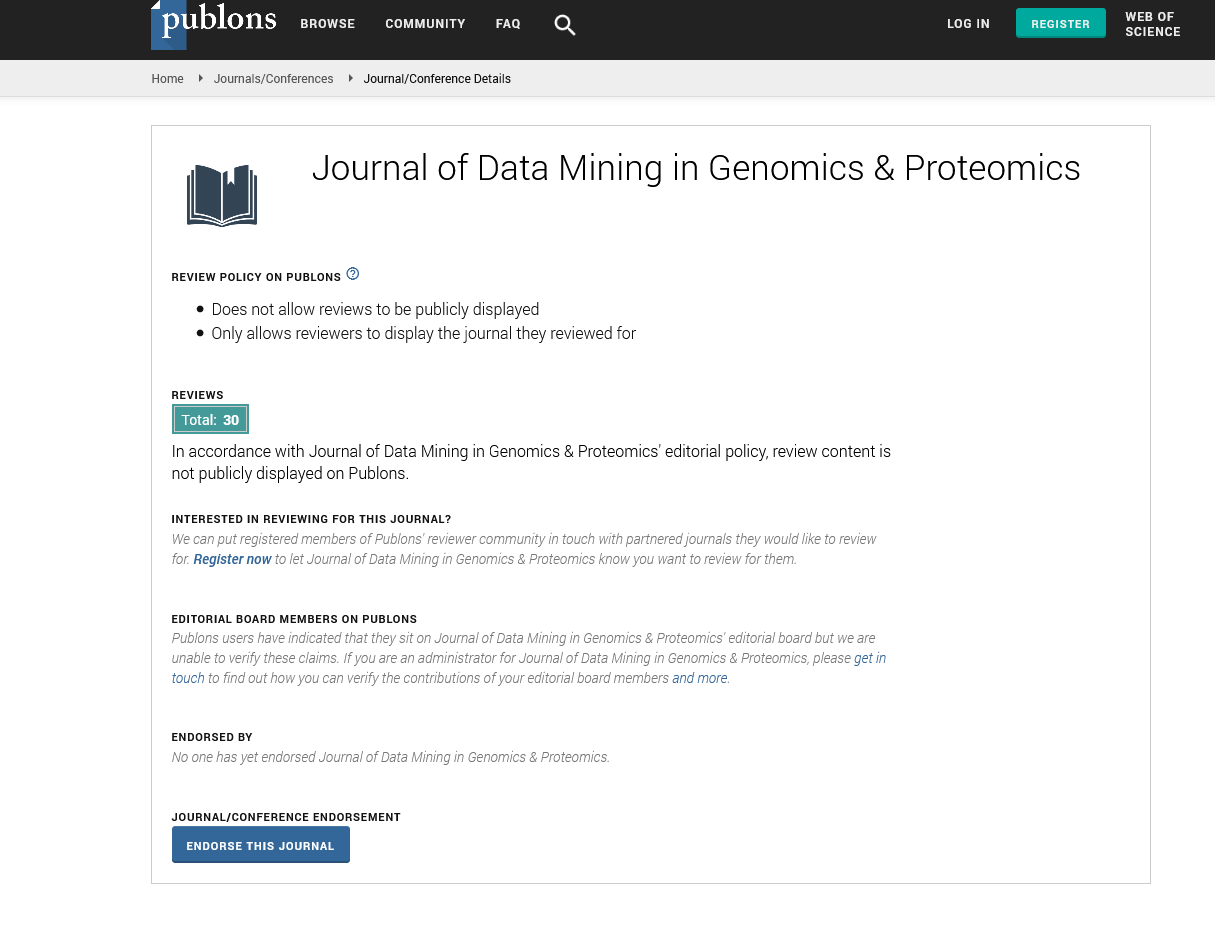Indexed In
- Academic Journals Database
- Open J Gate
- Genamics JournalSeek
- JournalTOCs
- ResearchBible
- Ulrich's Periodicals Directory
- Electronic Journals Library
- RefSeek
- Hamdard University
- EBSCO A-Z
- OCLC- WorldCat
- Scholarsteer
- SWB online catalog
- Virtual Library of Biology (vifabio)
- Publons
- MIAR
- Geneva Foundation for Medical Education and Research
- Euro Pub
- Google Scholar
Useful Links
Share This Page
Journal Flyer

Open Access Journals
- Agri and Aquaculture
- Biochemistry
- Bioinformatics & Systems Biology
- Business & Management
- Chemistry
- Clinical Sciences
- Engineering
- Food & Nutrition
- General Science
- Genetics & Molecular Biology
- Immunology & Microbiology
- Medical Sciences
- Neuroscience & Psychology
- Nursing & Health Care
- Pharmaceutical Sciences
Commentary - (2024) Volume 15, Issue 4
Advancements in Proteomics: Insights from Peripheral Blood and Serum/Plasma Analysis
Xiuling Zhao*Received: 20-Nov-2024, Manuscript No. JDMGP-24-27984; Editor assigned: 22-Nov-2024, Pre QC No. JDMGP-24-27984 (PQ); Reviewed: 06-Dec-2024, QC No. JDMGP-24-27984; Revised: 13-Dec-2024, Manuscript No. JDMGP-24-27984 (R); Published: 20-Dec-2024, DOI: 10.4172/2153-0602.24.15.366
Description
Proteomics, the large-scale study of proteins, has emerged as a transformative field in biomedical research, providing insights into the molecular mechanisms underlying various physiological and pathological processes. Among the diverse biological specimens used for proteomic studies, peripheral blood, specifically serum and plasma, holds the potential due to its accessibility and comprehensive reflection of the body’s physiological state. This article describes the advancements and applications of proteomics based on peripheral blood, with a focus on serum and plasma-based approaches.
Importance of serum and plasma in proteomics
Serum and plasma are widely used in proteomic studies because they are rich in proteins that represent an enlargement of the body’s metabolic and pathological conditions. Plasma, the liquid component of blood, contains fibrinogen and other clotting factors, whereas serum is derived from plasma after the removal of clotting factors. Both matrices are easily obtainable through minimally invasive procedures, making them ideal for clinical and diagnostic applications.
Proteins in serum and plasma include a diverse range of molecules, such as enzymes, hormones, cytokines and other biomarkers that reflect the physiological and pathological states of the individual. The study of these proteins can provide an important insights into disease mechanisms, identify novel biomarkers and support the development of targeted therapies.
Technologies used in blood-based proteomics
The complexity of the proteome in serum and plasma poses significant analytical challenges due to the vast effective range of protein concentrations. Highly abundant proteins, such as albumin and immunoglobulins, often mask low-abundance proteins that are of critical diagnostic or therapeutic interest. To address this, advanced technologies and methodologies are used.
Mass Spectrometry (MS): Mass spectrometry is a fundamental of proteomics, enabling the identification and quantification of proteins with high precision and sensitivity. Techniques like association Mass Spectrometry (MS/MS) and Time-of-Flight (TOF) are commonly used for detailed protein analysis.
Liquid Chromatography (LC): Coupled with MS, liquid chromatography is used to separate proteins or peptides before analysis, enhancing the resolution and depth of proteomic studies.
Affinity-based methods: Techniques such as immunoaffinity depletion are used to remove high-abundance proteins, allowing the detection of low-abundance proteins. Protein microarrays and Enzyme-Linked Immunosorbent Assays (ELISA) are also used for targeted protein analysis.
Isotope labeling and label-free quantification: These approaches enable comparative analysis of protein expression levels under different conditions, facilitating biomarker discovery.
Applications of serum/plasma proteomics
Serum and plasma proteomics have a wide range of applications in healthcare and biomedical research. Major areas include:
Disease biomarker discovery: Blood proteomics is instrumental in identifying biomarkers for early detection, diagnosis and prognosis of diseases such as cancer, cardiovascular disorders and autoimmune diseases. For instance, proteins like C-Reactive Protein (CRP) and cardiac troponins are well-established biomarkers derived from blood-based proteomics.
Drug development: Proteomic analysis of blood samples aids in understanding drug mechanisms, identifying therapeutic targets and evaluating drug efficacy and safety.
Personalized medicine: By analyzing individual protein profiles, proteomics supports the development of personalized treatment strategies customized to the specific molecular characteristics of a patient’s disease.
Monitoring disease progression and treatment response: Proteomic studies enable the tracking of changes in protein levels over time, providing insights into disease progression and the effectiveness of therapeutic interventions.
Challenges and future perspectives
Despite its potential, blood-based proteomics faces challenges, including the high complexity of the proteome, inter-individual variability and the need for strong and reproducible analytical workflows. Additionally, the standardization of sample collection, processing and data analysis is essential to ensure reliable results.
Looking ahead, advancements in technology, such as high- resolution MS, artificial intelligence and machine learning, are expected to revolutionize proteomics. These innovations will enhance the ability to analyze complex proteomes, identify subtle changes in protein expression and integrate proteomic data with other omics platforms for a comprehensive understanding of human health and disease.
Peripheral blood, particularly serum and plasma, serves as a valuable resource for proteomic studies, suggesting a wealth of information about the body’s physiological and pathological states. Advances in analytical techniques and computational tools have significantly expanded the potential of blood-based proteomics, driving progress in biomarker discovery, drug development and personalized medicine. As technology continues to evolve, serum and plasma proteomics will play an increasingly pivotal role in transforming healthcare and improving patient outcomes.
Citation: Zhao X (2024). Advancements in Proteomics: Insights from Peripheral Blood and Serum/Plasma Analysis. J Data Mining Genomics Proteomics. 15:366.
Copyright: © 2024 Zhao X. This is an open-access article distributed under the terms of the Creative Commons Attribution License, which permits unrestricted use, distribution, and reproduction in any medium, provided the original author and source are credited.

